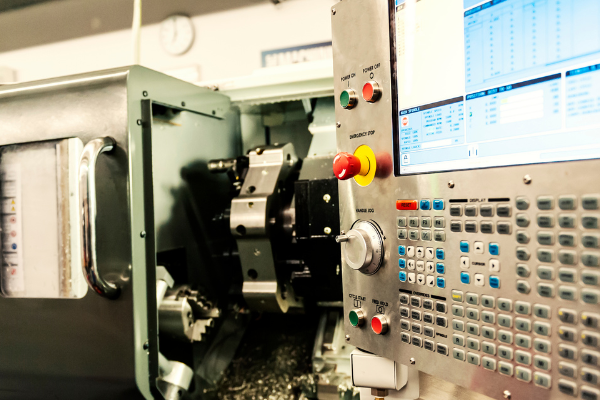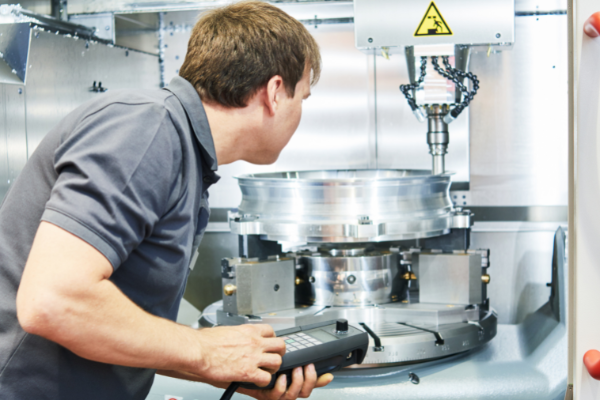Many customers have questions concerning general design recommendations for machined parts to the machine because no one has given them some answers to their questions before. So, we’ve collected a list of the best recommendations and tips centering around simple and quick machining strategy and practical application. We hope this selection will be handy for newbies and experts seeking to refine their general knowledge in this field.
Feature size
The minimum feature size that can be machined depends on the material, its hardness and strength, and the tooling used. Typically, the feature size is limited by the maximum cutter diameter allowed in your process. For example, if you’re using a V-tool with a 0.25-in.-diameter flute and 0.125-in.-deep pockets, then your usable feature size is probably 0.375 in., assuming you don’t want to go below half the depth of cut (0.0625 in.). For deeper pockets, you can get away with using a smaller cutter or multiple passes; however, this limits how much material can be removed in one setup and increases cycle time.

Part volume
The larger and heavier the part, the more material it must support to remain rigid while being worked on by a machine tool. This means that larger and heavier parts require more time to machine than smaller ones. Also, large parts may require special tools, fixtures, or setups that increase the cost of manufacture. The extra time required to machine these parts is often not worth it because of the increased cost per unit produced.

Shrinkage allowance
One of the most important factors in determining the quality of a machined part is its shrinkage allowance. Shrinkage allowance is the difference between the size of a finished part and its original CAD drawing. As a general rule, the greater the accuracy required by a job, the more important it is to allow for shrinkage during machining.
There are two types of shrinkage: primary and secondary. Primary shrinkage occurs when a tool removes material from a part, changing its size. Secondary shrinkage occurs when there is no material left for the tool to remove, but it still creates an impression on the surface of a part due to its rigidity. This type of shrinkage can be minimized through proper tool selection, setup, and effective cooling practices during machining operations.

Draft requirements
The draft requirements for a part are the amount and direction of angular deviation from the vertical. The requirement may be specified as a positive amount or as zero. For example, if a feature on an external surface is ground at 45 degrees from the vertical, the draft requirement would be +45 or – 45 degrees.
You can specify the draft angle directly in your model file if you are using solid modeling software, such as Autodesk Inventor, SolidWorks, and others. If you create surfaces using CAD software such as Pro/Engineer, you can use commands to specify the desired draft angle. If you have a surface that has already been created and wish to change its draft angle, use commands within your CAD program to modify it.
The following general design recommendations apply to all types of surfaces:
Machined parts should have no more than four sides per feature and no more than three sides per corner; this ensures maximum strength for machining purposes.
The thickness of all machined parts must be greater than twice their largest diameter (for example, if your largest diameter is 0.25 inches, then your maximum allowable thickness should be 0.5 inches).

Wall thickness
The wall thickness of a part is one of the most important factors in determining the strength and stiffness of that part. The wall thickness should be designed to meet the application’s requirements, but it should also be designed about material costs. The material’s machinability may affect your decision on what thickness to use. For example, if you use a very hard material such as stainless steel, you may want to use a thinner wall for strength reasons. If you are using a softer material like aluminum or brass, then there is less concern about strength and stiffness and more about how easy it will be to machine that part. Wall thicknesses should be specified by diameter (OD) and length (ID).

Consider your materials
Every material has characteristics that affect how easily it can be machined and what kinds of tools can be used. For example, aluminum is much softer than steel but also easier to machine because it doesn’t require as much force or speed when cutting through it compared to steel which requires high speeds to stay cool enough so that it doesn’t overheat burn up during machining operations.

Minimum hole diameter
Minimum hole diameter: A drilled hole’s minimum diameter should be equal to or greater than the largest diameter of any feature that passes through it. If the smallest dimension of your feature is less than the minimum size of your drilled hole, you will have to enlarge it with a boring bar.
Maximum depth: The depth of a drilled hole should not exceed 10 times its diameter. If your home has more than one feature passing through it, subtract 10% from this limit for each additional feature and use that new maximum depth as your limit instead.
Minimum radius: The minimum radius of a turned edge should be equal to or greater than half the thickness of the workpiece material being used. If the smallest dimension of your feature is less than half the thickness of your work surface material, you will have to re-profile it with a milling tool or similar device before turning it into an edge.

Avoid sharp corners and edges
Avoid sharp corners and edges. Sharp edges can lead to stress concentrations, which may cause cracks to form. The sharper the angle, the greater stress concentration that will occur at that point on your part. This is why it’s important to use round or chamfered edges whenever possible instead of sharp corners or edges.
Avoid thin walls and unsupported features. Thin walls are more likely to break during machining than thicker ones because they are under greater stress than thicker walls (due to their reduced cross-sectional area). Unsupported features represent areas where there isn’t sufficient material behind an edge or corner to keep it intact while machining; these areas will also be under high stress.

Conclusion
I hope that this article provides some insight into designing a well-machined part. Following these recommendations should help you to save money, reduce your machine cycle times, layout cleaner parts, and reduce scrap. Your parts are important for your company, so design them well.




